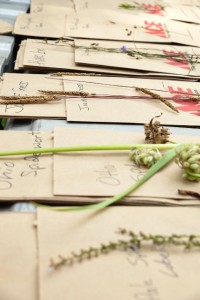Heritage Valley: The little things in life
By Mary Runkel on July 31, 2015 in Blog

An Iowa DNR member presents on a plant species to an attentive volunteer. (Photo by Jessica Rilling)
As I reflect back on our summer seed harvest on July 9 up and around Heritage Valley in northeast Iowa, I think to myself “What a great day!” But I think that I say that a lot—so this time I'll do my best to answer WHY it was so great.

INHF blufflands director Brian Fankhauser points out plant species to a volunteer. (Photo by Jessica Rilling)
First off, we got to be outside during the work week. Bam. Two, the weather cooperated. Double bam. Three, we gathered a bunch of extremely prairie-passionate people (of all ages) to roam the land and look for seeds to put in our buckets. One exclaims, “Look-ey here!” as they find a rare species, another shouts aloud, “Brian, will you come take a look at this?” There are curiosity and answers and hands-on discovery.
Every time we have a seed harvest, I learn more and more about our awesome natural heritage. My background is in English (and not natural resources… yet…), so I get to learn how to identify these plants alongside the volunteers who participate in our events. And though the events wouldn't be possible without our (wonderful, knowledgeable) natural resource professionals, I believe there's value in the non-professional's experience, too. So I thought I'd share what I personally found interesting about some of the species we collected (with help from INHF's Land Stewardship crew, many that attended the event, Sylvan Runkel and Dean Roosa's Wildflowers of the Tallgrass Prairie and An Illustrated Guide to Iowa Prairie Plants by Paul Christiansen and Mark Muller):
1) Ohio spiderwort (Tradescantia ohiensis): Look around for this—I found it growing in my friend's backyard not far from his pool! Once you know it, you'll never forget it. Also, some species have been found to change flower color when exposed to nuclear or radioactive radiation! How wild is that? Apparently some environmental/activist groups use it as an indicator of radiation or nuclear activity in areas around nuclear plants.

Examples of the species made recognition easier for volunteers. (Photo by Jessica Rilling)
2) Pale-spiked lobelia (Lobelia spicata): This dainty stem of a plant was fun to find. Apparently it contains alkaloids that are similar to nicotine and, when it's a dry year or plants are in short supply, some animals may eat enough to be poisoned!
3) Blue-eyed grass (Sisyrinchium campestre): So TINY! And the seeds are found in a little round capsule! I couldn't believe when they showed me the ready-to-collect species- I was amazed! I read that this was used as a tea for stomach cramps and with another species, a tea could be made for hay fever.
4) Hoary puccoon (Lithospermum canescens): Talk about finding a needle in a haystack! This species has tiny little seeds on it, just in the middle of the leaves toward the stem, and most of them had already dropped. So I was proud to find ONE plant that still had seed. Mission accomplished.
- Other species we collected: Harebell (Campanula rotundifolia), June grass (Koeleria cristata) and Downy painted cup (Castilleja sessiliflora)
Lastly, I wanted to mention how cool it was to listen to the stories of current and former interns. At this particular event, we had a total of eight present and past interns:
- Jessica Rilling, a former land stewardship intern in 2005, program intern in the office in 2006 and staff member (Buckmaster/McElroy)
- Laura Helmich, statewide land stewardship intern from 2011 (Rose Mary Schwent Intern)
- Tyler Bruck, statewide land stewardship intern in 2013 (Svare Intern)
- Derek Miner, statewide land stewardship intern in 2014 (Straver's Intern)
- Our blufflands interns were also present—Lauren Mordini, Tori Hartman, Eddie Conrad, Devin Schroeder and Sarah Klein (Buckmaster/McElroy Interns)

Moral of the story? There's always something to discover, no matter how big or small. Come join us on our next seed harvest if you'd like to discover alongside us.
Until then,
Mary
